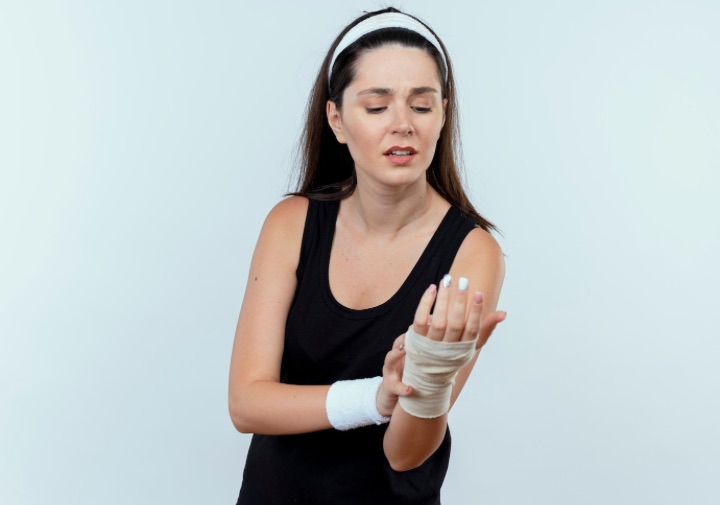A broken wrist can be a painful and debilitating injury, causing difficulty with daily tasks and impacting the overall quality of life. The wrist comprises several small bones, which can be broken or fractured due to a sudden injury or trauma.
Whether it is a sports injury, fall, or car accident, a broken wrist can occur due to various reasons. Understanding the symptoms of a broken wrist and seeking medical attention promptly is essential for preventing further complications or permanent damage.
A broken wrist, also known as a wrist fracture, occurs when at least one of the bones in the wrist is either partially or completely broken. It is a common injury that can result from a variety of causes, including falls, sports injuries, and car accidents.

Photo Credit: Freepik
Symptoms can vary depending on the severity and location of the fracture. Common symptoms include:
There are two main types of wrist fractures:
If you suspect you have a broken wrist, seek medical attention immediately. Getting an accurate diagnosis and proper treatment is important to ensure proper healing and prevent further complications.
A broken wrist can occur due to various reasons. The most common cause of a broken wrist is a fall onto an outstretched hand, which can happen during common activities such as playing sports, cycling, or even simply walking on an uneven surface.
Car accidents, physical assaults, and other forms of trauma can cause a broken wrist. In some cases, repetitive stress on the wrist due to certain activities or conditions, such as osteoporosis, can also lead to wrist fractures.
Some individuals may be more prone to wrist fractures than others due to certain risk factors. These include:
It is important to note that while these factors may increase the risk of a broken wrist, anyone can experience a wrist fracture regardless of age, gender, or activity level.

Photo Credit: stockking
Once a broken wrist has been diagnosed, the patient’s doctor will discuss the best treatment options based on the severity of the fracture. Treatment may involve immobilizing the wrist with a splint or cast, or in some cases, surgery.
Immobilization: A simple wrist fracture can usually be treated with immobilization. A cast or splint will be placed around the wrist to keep it still, allowing the bones to heal properly. The immobilization period usually lasts for 6-8 weeks.
Surgery: In more severe cases, surgery may be necessary to realign the broken bones and put them back into place. The surgeon may use pins, screws, or plates to hold the bones in place as they heal. After surgery, a cast or splint will be placed around the wrist to keep it immobilized.
Physical therapy: Once the cast or splint is removed, physical therapy may be recommended to help the patient regain strength and mobility in the wrist. This may involve exercises to help build up the muscles and stretching and range-of-motion exercises.
Pain management: Pain medications may be prescribed to help manage the pain associated with a broken wrist. Over-the-counter pain relievers such as acetaminophen or ibuprofen may also be recommended.
The healing process for a broken wrist can take several weeks or even months, depending on the severity of the fracture. During this time, it’s important to follow the doctor’s instructions carefully, including any recommendations for physical therapy.

Photo Credit: nakaridore
Resting the wrist as much as possible during the healing process is also important. This may mean avoiding certain activities that could put extra stress on the wrist, such as weightlifting or playing sports.
Finally, eating a healthy diet and getting plenty of rest is important to help the body heal properly. This can help speed up the healing process and reduce the risk of complications.
If surgery is necessary to treat a broken wrist, several different types of surgical procedures may be used. These may include:
After surgery, the patient will need to wear a cast or splint to immobilize the wrist as it heals. Physical therapy may also be recommended to help regain strength and mobility in the wrist.
Recovering from a broken wrist can be a lengthy and challenging process, but it’s crucial to take the time necessary to allow your wrist to heal properly. Your doctor may recommend physical therapy to rebuild strength and flexibility to your wrist and help you regain mobility.
During recovery, it’s essential to follow your doctor’s instructions and avoid any activities that strain your wrist unnecessarily. This includes heavy lifting and any high-impact activities such as sports that could cause a re-injury.

Photo Credit: Freepik
After fully recovering from a broken wrist, taking precautions to prevent further injuries is essential. Here are some measures you can take:
Protective Gear: Use protective gear, such as wrist guards or gloves, when participating in high-impact activities that could put stress on your wrist.
Proper Technique: Practice proper technique when performing activities that require repetitive wrist motion, such as typing or playing musical instruments. Ergonomic equipment, such as a keyboard or mouse pad, could reduce strain on your wrists.
Stretching: Incorporate wrist stretching and strengthening exercises into your daily routine to help prevent injuries and maintain wrist health.
Regular Check-ups: Schedule regular check-ups with your doctor to monitor your wrist’s progress and ensure it’s healing correctly.
By taking these precautions, you can reduce the risk of re-injury and maintain the health of your wrist, enabling you to continue doing the activities you love without interruptions.
A: Common symptoms of a broken wrist include severe pain, swelling, bruising, difficulty moving the wrist, and a visible deformity.
A: The main causes of a broken wrist are falls, sports injuries, direct blows to the wrist, and car accidents.
A: Yes, some risk factors that increase the chances of a broken wrist include osteoporosis, certain sports activities, and age (older adults are more prone to wrist fractures).
A: Treatment options for a broken wrist may include casting or splinting, medication for pain relief, physical therapy, and in some cases, surgery.
A: The recovery time for a broken wrist can vary depending on the severity of the fracture and individual healing factors. The wrist typically takes several weeks to a few months to fully heal.
A: While it’s not always possible to prevent every wrist injury, there are steps you can take to reduce the risk, such as wearing protective gear during sports activities, practicing proper safety techniques, and maintaining strong bones through a healthy diet and exercise.